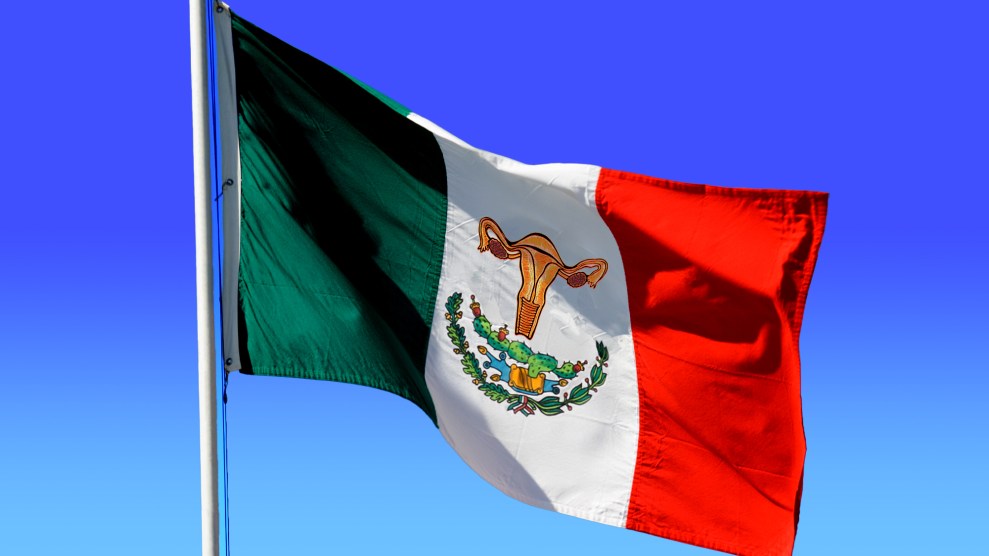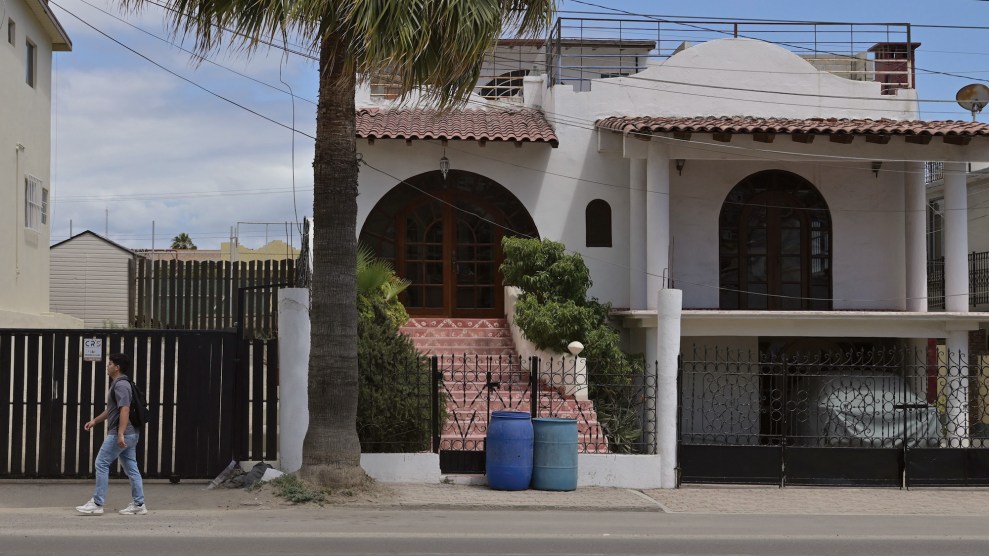
Mother Jones illustration; YangYin/Getty
One last-minute round-trip flight from Biloxi, Mississippi, to Cancún, Mexico, runs about $171 USD; three nights at a three-star hotel there can cost as little as $129. A three-day car rental in the resort town rings in at just $20 per day. And the price for one surgical abortion at MSI Reproductive Choices’ Cancún clinic would be about $350. The total cost for a trip to Cancún to access reproductive health services no longer available in some American states? $710.
Starting November 23, when the international sexual health organization MSI Reproductive Choices opens the doors to its first Cancún reproductive health center, a pregnant American from a US state where abortion is banned could find the procedure to be both more affordable and more accessible in Mexico. Quintana Roo, the Mexican state where Cancún is located, has become one of at least a dozen Mexican states to decriminalize abortion in the last two years amid a series of judicial rulings that have strengthened reproductive rights, culminating in a September Mexican Supreme Court ruling that made state laws criminalizing abortion unconstitutional nationwide.
While $710 is not an insignificant sum for a pregnant person living near the poverty line in America, it could still turn out to be several hundred dollars less expensive than the costs associated with obtaining similar treatments in post-Dobbs America, where 14 states have banned abortion completely, and four more have restricted it to the first trimester. A surgical abortion alone can cost more than $1,000 in the US, on top of out-of-state transportation and lodging needs. All these factors came into play when MSI planned its Cancún annex, which is being funded by an anonymous US donor.
“It is funny that sometimes it may be cheaper for you guys to come to Cancún than for us to go to Cancún,” says Araceli López-Nava, MSI’s Latin America regional managing director. Indeed, dozens of US airports offer nonstop flights to the popular Mexican vacation destination. “We thought the specific location could definitely help American women—with the additional benefit of lower prices that we have in Mexico compared to the US.”
Called “reproductive health migration” by abortion-rights advocates and “abortion tourism” by detractors, people from multiple continents have crossed international borders seeking reproductive health care for decades. Traveling internationally for healthcare is a common practice in abortion-restricted Poland, some South American countries, and parts of Asia, for example. But the movement has gained new urgency and visibility after the US Supreme Court overturned Roe vs. Wade in June 2022, spurring some US states to adopt more restrictive abortion laws just as Mexican states were loosening theirs.
MSI—which provides services such as affordable and safe contraceptives, abortions, vasectomies, and treatment for sexually transmitted infections in 37 countries—has embraced shifting abortion positions in the international community in a number of ways to facilitate more accessible reproductive healthcare. Its new Cancún clinic is just one example of how the Latin American branch of the organization has expanded its mission to assist residents in the US. One week after the fall of Roe, MSI opened a reproductive health center in Tijuana, a Mexican border city 16 miles from San Diego, California, where now, MSI estimates, about half of its patients are from the US. While states like Arkansas and West Virginia float new laws on medication abortion, and a federal lawsuit challenges the Food and Drug Administration’s approval of the medication-abortion regimen component mifepristone, MSI is also launching a telehealth service this month that will enable pregnant people to have virtual medication abortion consultations from anywhere, and then pick up their prescriptions from postal carriers in Mexico.
MSI is not the only option for Americans, who also can take matters into their own hands by making a cross-border trek to a Mexican pharmacy and pay as little as $20 USD to purchase one abortifacient—misoprostol—over-the-counter, no questions asked. As an alternative to international travel, Mexican-based grassroots reproductive justice organizations like Las Libres are also helping hundreds of pregnant Americans obtain abortion pills from Mexico each month via mail.
This cross-border care infrastructure is merely the latest iteration of a whipsawing reproductive rights saga that has existed between the United States and Mexico for more than half a century. Today, Mexicans are helping Americans procure abortion services, but in the past, the roles have been reversed—a consequence of the influence of money, politics, and religion in each country. As Lina-Maria Murillo, an assistant professor of gender, women’s and sexuality studies at the University of Iowa, notes, “There is a long history of people crossing the US-Mexico border for care.”
Before the Civil War, abortion, typically performed by midwives, was legal in the US. But amid declining birthrates and a crusade by male physicians to dominate obstetric health, US states began to limit abortion rights, with every state imposing some abortion restrictions by the end of the 19th century. In the wake of these new laws, women traveled to Mexico, where the procedure may have been illegal but laws were seldom enforced. By the 1960s, Murillo wrote in her dissertation, flying into El Paso, Texas, on Fridays to cross the border into Juárez, Mexico, became so popular that flight attendants dubbed the trend “abortion flights.”
By 1970, Mexican abortion clinics near the border became more lucrative and, in some cases more dangerous with a few bad actors providing substandard care to desperate women. Law enforcement from both countries began to crack down, forcing clinic closures and launching fear-mongering campaigns. One Juárez physician, for example, was extradited to California after pleading guilty to charges related to “an abortion ring involving El Paso, Juárez, San Diego, and Tijuana,” Murillo’s research shows. Meanwhile, Juárez newspapers printed the names of Mexican physicians providing abortions to Americans, the clinical staff assisting in the work, and the American women who had sought them out to add to the intimidation.
As options in Mexico became increasingly constrained, the US Supreme Court in 1973 established the constitutional right to an abortion in its Roe vs. Wade decision. At that point, the traffic pattern reversed, with an uptick of Mexican women crossing the border into cities like El Paso for reproductive care.
Then around 2015, El Paso’s last remaining abortion clinics began to close, and in September 2021, Texas enacted Senate Bill 8, which banned abortions as early as five or six weeks gestation, and allowed private citizens to sue abortion providers and any other individual who “aids or abets” abortion. Around the same time, Mexico’s highest court ruled that criminal penalties for abortion in the northern state of Coahuila were unconstitutional, thus clearing a path to more liberal abortion laws throughout the country.
When the US Supreme Court delegated the ability to restrict abortion to individual states in Dobbs v. Jackson Women’s Health Organization in June 2022, more than a dozen states moved to immediately ban or place strict limitations on abortion. Almost overnight, Mexico reemerged as the more progressive country fighting for reproductive rights.
Both global and grassroots organizations have seized on the changes of direction to help more people from more places access reproductive care from Mexico. MSI has stood up brick-and-mortar solutions, whereas other organizations like Las Libres—an activist network that helps pregnant people procure abortion pills—are helping Americans more covertly, through word of mouth.
Las Libres founder Verónica Cruz Sánchez was well-positioned to provide assistance to pregnant Americans living in newly abortion-hostile US states. She founded Las Libres in the deeply conservative Mexican state of Guanajuato in 2000 in response to Guanajuato lawmakers trying to eliminate rape as an exemption to its already strict abortion laws.
While Las Libres fought the legislation, Cruz realized most victims of rape were forced to have children even when abortion was technically an option. In response, Las Libres expanded its mission, forming a community of gynecologists, psychologists, and private lawyers to help Mexican rape victims obtain abortions, regardless of local laws. They expanded further in order to help pregnant people regardless of whether the pregnancy was the result of rape. “If you’re a victim of rape or not, an abortion is the same process,” Cruz says. “So we decided since then to take it into our own hands to guarantee women’s rights to access safe and free abortions without stigma and stereotypes.”
By 2015, social media and word of mouth propelled the growth of Las Libres to provide support to women throughout Mexico. The following year, the organization expanded to Central America and some parts of South America. In 2021, as Mexico’s Supreme Court issued its first ruling decriminalizing abortion, and Texas simultaneously moved to criminalize it, Las Libres reinvented itself to help people in Texas by helping them obtain abortion pills from Mexico. When Roe fell, Las Libres was able to assist people all across the US. Since January 2022, the organization has worked with more than 20,000 US residents.
“Today, any Mexican woman can go to a drug store to buy the medication knowing it’s legal, that it’s not a crime, and that they can do it. They have all of the options. Las Libres isn’t the only one anymore,” Cruz says. The same is not true in the 18 US states with very restrictive abortion laws, which is why, Cruz notes, Las Libres now supports “many more women from the United States than from Mexico. Not because Mexican women aren’t getting abortions, but because today they have many options.”
With abortion access becoming more difficult in the US, experts predict Americans’ renewed reliance on Mexico for reproductive healthcare will continue to grow. Murillo, for instance, anticipates more abortion clinics appearing just south of the border, in much the same way as took place in the mid-20th century.
To be sure, relying on international groups or crossing the border for reproductive healthcare is not universally accessible. For starters, these trips require a valid passport, something an estimated two-thirds of US citizens don’t possess. Flights and accommodations can be cost-prohibitive. Abortion pills, like those offered by Las Libres, are only recommended up to 10 weeks gestation. The fact that Mexico’s decriminalization laws are relatively recent also means only limited clinicians and facilities are equipped to provide surgical abortion care there. Plus, traveling to Mexico isn’t a solution for undocumented migrants in the US who face unwanted pregnancies, since returning to the US could prove to be impossible.
But after some brief delays in obtaining all the necessary licensing permits, MSI’s new Cancún clinic will serve as one more option for some Americans seeking reproductive healthcare. “Whoever needs our help,” says Araceli López-Nava of MSI, “we would be happy to serve.”
Additional reporting by Isabela Dias.
















